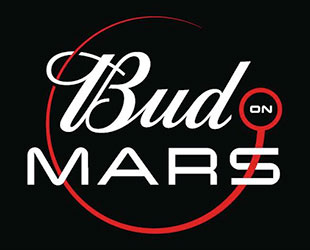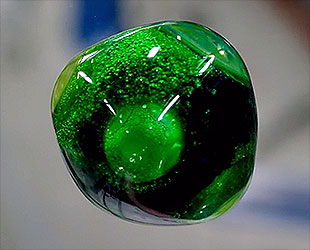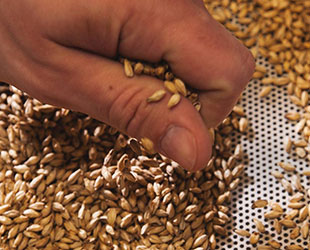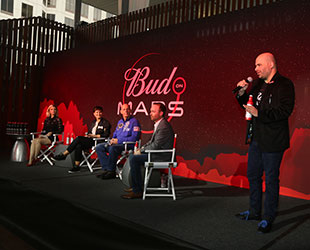March 13, 2017 – Budweiser has set its sights on brewing the first beer on Mars.
"The King of Beers" announced its "Bud on Mars" initiative — including a partnership that could lead to flying malt and other experiments on the International Space Station — on Saturday (March 11) at the South by Southwest festival in Austin, Texas.
"This takes the Budweiser experience to the future, where colonization and socialization might go," Valerie Toothman, Anheuser-Busch's Vice President of Marketing Innovation, said during a panel discussion devoted to brewing beer on the Red Planet.
"We know that travel to Mars might still be a decade or two away, but this is the first step in the journey in a long-term commitment by the company to make sure that when we get there and we achieve that American dream, Budweiser is the beer people will be toasting with and will be enjoying there on Mars," said Toothman.

Budweiser's "Bud On Mars" logo. (Budweiser/Anheuser-Busch) |
The early evening event, which included a happy hour with specially-labeled "Bud on Mars" beer, also featured former astronaut Clayton Anderson and Patrick O'Neill, marketing and communications manager for the International Space Station U.S. National Laboratory at CASIS, the Center for the Advancement of Science in Space. Actress Kate Mara, who played an astronaut in the 2015 movie "The Martian," moderated the panel.
"I'm so flattered to be here, but I don't at all feel qualified," said Mara. "That said, I will just go with it and do what I did when I made the movie 'The Martian' and pretend like I am a genius when it comes to space."
Burps, pops and hops
A mission to send humans to the Red Planet is well-within NASA's long-range plans, said Anderson, who is a veteran of two space missions, including spending 152 days on the space station. "A successful mission will include many key components, including the need to provide crew members with commodities that remind them of home."
"Popping the top on a cold Budweiser mid-mission could very well be one of those things," he wrote in an email sent to collectSPACE after the panel.

A carbonated color-water bubble on the space station. (NASA) |
"While the idea poses considerable technical challenges, the concept – which may lend itself to some valuable initial test ideas and experiments on the space station – is valid and potentially worthy of consideration with respect to a commercial partnership," Anderson added.
Beyond the possible issue of "wet burps" ("you just tumble a few times and all the liquid in your stomach will separate from the air; then you burp a solid dry burp," Anderson told the panel to laughter), there are also container concerns. Astronauts during the space shuttle-era experimented with non-alcoholic carbonated beverages in the 1980s, but the cans, cups and dispensers were unsuccessful.
"When you have a Budweiser and you pop the top [of the bottle], the pressure inside is higher than outside, so things will happen. As soon as the lid is popped on Earth, you let it 'fizz' and you enjoy. In space, it 'pops,' and then maybe you'd need to clean everything," described Anderson, who wrote about his experience with alcohol in orbit in his book, "The Ordinary Spaceman" (Univ of Nebraska Press). "That would be an interesting dilemma to solve for the engineers at Anheuser-Busch."
The pull of gravity on Mars, which is about one-third of that on Earth, may help with bottle designs, but the distance to the Red Planet from our home planet may mean having to grow and source the main ingredients to brew Budweiser on Mars.

Barley malt used in the making of Budweiser beer. (Budweiser) |
The American-style pale lager is made of two- and six-row malt, rice, hops and is propagated from the original strain of yeast as was first used by Adolphus Busch in 1876. And that is just 10 percent of the recipe.
"Beer at its core is 90 percent water," said Toothman. "And does everyone know what doesn't exist on Mars' surface? Water. There is ice and [other sources] like that, so we are going to learn about that."
Bud on Mars, for the benefit of Earth
"My 'enginerdiness' loves that we might completely rethink what it takes to deliver the signature Budweiser experience when we colonize Mars," Toothman said.
Acknowledging that it may still be decades before there is a colony in need of a beer, Budweiser has identified some short-term studies it can do to advance its long-term goal while also benefiting the brand today.
"We realized there could be benefits about what we would learn that could make our product – here on Earth – even more efficient, and help make a better world, which is also a part of the Budweiser dream," said Toothman.
Budweiser and CASIS have recently agreed to look at how the U.S. National Lab on the International Space Station could be used to improve the brewing company's products and processes, said O'Neill.
"It is the role of CASIS to seek out new and non-traditional research partners interested in leveraging our orbiting lab," O'Neill said in an email to collectSPACE. "No flight projects have been selected at this point, but we are always excited to participate in discussions with unique brands who have an interest in microgravity research for terrestrial benefit."
Toothman said during the panel that working with CASIS could help the company with making "short-term sprints."

"Bud On Mars" panel at the South by Southwest festival in Austin, Texas on March 11. (Jack Plunkett/Invision for Budweiser/AP Images) |
"We've already started to construct a set of experiments to take our barley malt up to the space station to understand what kind of effect those low Earth orbit conditions puts on [the grains]," she said. "Then, bringing [the grains] back to Earth, planting them, growing, harvesting and testing them and understanding what kind of changes might happen."
Such an experiment, together with longer-term studies into genotyping and DNA, could help create the ultimate barley strain for disease-resistance, drought-resistance and yield, Toothman explained.
"That will help us be part of creating a better world with the same Budweiser on Earth in the shorter term," she said.
For more about the U.S. National Laboratory, see CASIS's website. For more about Clayton Anderson, see here.
